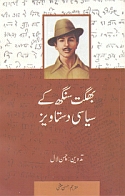People Like Us Across The Border

Ode To A Hero
M. Tahir Speaks to Seasoned Author Chaman Lal Who Has Just Penned Another Book on Bhagat Singh

‘The sword of revolution is sharpened at the whetstone of thoughts.' You mention ‘Bhagat Singh' and see the spark in his eyes. He is Chaman Lal, author and educationist who teaches Hindi but breathes Punjabi and Urdu. For long Lal has been relentlessly trying to paint the ‘true picture' of the revolutionary through his writings. His latest book, “Bhagat Singh Key Rajneetik Dastavez”, published by National Book Trust and translated into Urdu by Hasan Musanna, titled, “Bhagat Singh Ke Siyasi Dastavez” has just hit the stands. Timely too considering Bhagat Singh's anniversary has just been observed across the country. This 233-page paperback is priced at Rs.85.
Lal, former Chairperson, Centre for Indian Languages, JNU, is a man on a mission. Delivering lectures, writing articles and books on Bhagat Singh has made Lal an authority on him. It all started four decades ago in his native place, Rampura Phul, Bhatinda. Then Hind Pocket Books brought out a series on the freedom fighters which was serialised in “Desh Bhakt Yadan” in Punjabi. This got Lal interested in Bhagat Singh. He has not looked back since.
This book is important as the documents throw enough light on Bhagat Singh's beliefs. They prove beyond doubt his deep thoughts and clear political vision, based on Marxism. In fact, Bhagat Singh, keenly aligned with Lenin's views, was studying Lenin till just before the hanging.
Why another book?
If you ask Lal, ‘why another one' as he has already penned half a dozen books on the revolutionary in different languages, he says, “See, people don't think of Bhagat Singh beyond a freedom fighter who threw a bomb in Delhi Assembly and was hanged by the British. I want to change this mindset and bring out the real Bhagat Singh, the intellectual who could have been a hero of the masses, at par with Gandhi if not better, due to his deep political views and a clear roadmap to freedom!”
According to him the British Empire was seeing in him an ideological hero and a leader like Lenin and the history has neglected this revolutionary and reformer. He aims to right this wrong with the new venture in a country that is at times guilty of selective memory.
The documents collected in this book show Bhagat Singh in a new perspective who by his own admission was an atheist who refused to say ‘Wahe Guru' before hanging. His dislike for Naram Dal, old stalwarts of freedom struggle, the Non-cooperation Movement and a policy of wait and watch is more than evident. He was the man of action rather, truly following the French revolutionary, Vaillant, who had said, “It takes a loud voice to make the deaf hear.”
He was also influenced by communist reformers and was impressed by the popular unrest during the 19th Century around Europe, America and Russia, specially the Tsar period. According to Lal, Bhagat Singh was the first freedom fighter who brought ‘Inquilab Zindabad' slogan into political arena while throwing the bomb in Delhi Assembly.
Why this translation in Urdu? Lal shuffles in his seat looking into the collection on his desktop to inform that Zahida Hina of Pakistan has called Bhagat Singh a ‘Pakistani Shaheed' and this Urdu book would support a Pakistani democratic movement or more aptly a Left democratic movement.
He is also striving to set up an archive on the lines of Gandhi and Nehru.
Beyond literature, even cinema has focussed on Bhagat Singh. Just a few years ago we had a spate of films on the revolutionary. Lal is clear about the portrayal of Bhagat Singh in films.
According to him the character of Bhagat Singh was more objective in Rajkumar Santoshi directed flick, The Legend of Bhagat Singh. He didn't like Ramanand Sagar's Bhagat Singh but found Guddu Dhanoa's Shaheed touching for its songs. He, however, has serious reservations about the much talked about Rang De Basanti. For the moment though, he would have us all reading Bhagat Singh. The language can be of our choice, the subject remains the same.
From: Hindustan Times, October 7, 2010